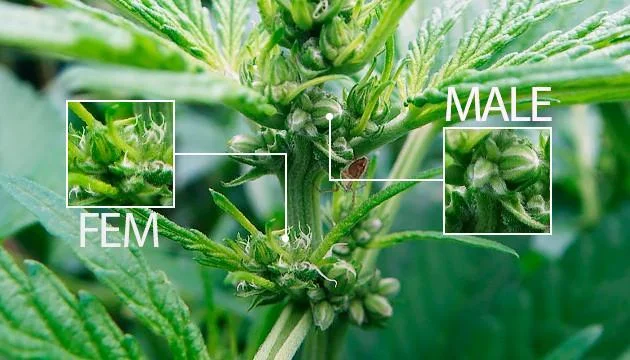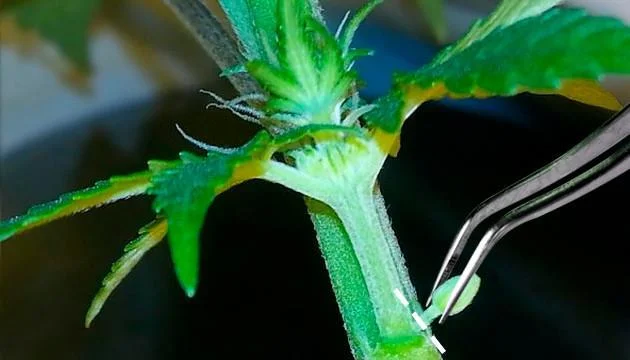The Hermie plant, short for “Hermaphrodite plant,” is an intriguing phenomenon in the plant kingdom. The majority of plants have separate reproductive organs for males and females. But Hermie plants have both. This makes them able to self-pollinate. This unique trait can be found in various plant species.
In the world of plant cultivation, Hermie plants are especially noteworthy. They can impact the quality and yield of the crop, making it crucial for growers to identify and manage them effectively.
Managing and growing plants is a difficult task, and among the growth of Hermie plants can cause serious difficulties for farmers. It can wreak havoc on crops, causing big losses in yield and revenue.
Hermie plants often develop due to stress, environmental factors, or genetic predispositions. Although self-pollination may seem beneficial, it has drawbacks and advantages. It is essential to look for early signs of the Hermie plant.
Growcycle is a company that specializes in providing products and tools. They help gardeners take control of their Hermie plants. The goal of these supplies and equipment is to simplify and improve the management of Hermie plant growth. They offer a range of watering systems, such as drip irrigation, sprinklers, and timers. Watering can be done on purpose with these systems. They are easily modified to meet the unique requirements of Hermie plants.
Why is It Important to Detect Hermie Plant at Early Stage?
Hermaphroditism can affect crop management as it often leads to uneven ripening of fruits or seeds. Farmers can identify hermaphroditic plants early. They can then isolate or control their pollination. This prevents any harm to the crop.
If left undetected, they can produce seeds with bad traits, leading to lower yields or worse crop quality. Early detection minimizes any possible financial damages and allows the elimination of harmful plants.
Early Signs of Hermie Plant
Early signs of Hermie Plant abnormalities are essential for efficient management. Here are some essential signs to be aware of:
Development of Both Sexual Organs
There are reproductive organs on Hermie plants for both sexes. Look for pollen sacs (male) and pistils (female) on the same plant. This dual structure is a clear indicator of hermaphroditism.
Development of Pollen Sacs
Pollen sacs, also known as “bananas” due to their shape, are a common sign of a Hermie plant. These sacs contain pollen and can appear alongside female flowers. Regularly inspect the plants for these structures, especially if growing medicinal plants.
Stress-Induced Changes
Stress is a significant factor that can trigger hermaphroditism in plants. Watch the plants for signs of stress. These signs include changes in light, temperature, damage, or nutrients. Minimizing stress can help prevent the development of Hermie’s traits.

Positive Effects of Hermie Plant
While the concept of a Hermie plant might initially seem problematic, it does offer some distinct advantages for gardeners and plant enthusiasts.
Self-Pollination
One of the primary benefits of Hermie plants is their ability to self-pollinate. This trait can be particularly useful in isolated or controlled environments with scarce pollinators. By self-pollinating, Hermie plants can ensure the continuation of their species without relying on external factors.
Genetic Diversity
Hermie plants contribute to genetic diversity within a plant population. A species’ resistance against pests, illnesses, and environmental changes can be strengthened by its diversity. In some cases, the genetic variation introduced by Hermie plants can lead to the development of new and improved plant varieties.
Reproductive Assurance
For gardeners who face challenges in ensuring pollination, Hermie plants offer reproductive assurance. These plants can produce seeds and fruit even without pollinators, making them a reliable option for maintaining plant populations.
Negative Effects of Hermie Plant
Despite their unique traits and benefits, Hermie plants also come with several drawbacks that gardeners should be aware of.
Reduced Quality
In the case of medicinal plants, Hermie plants can negatively impact the quality of the crop. Hermaphroditic plants often produce seeds, which can reduce the potency and overall quality of the harvested buds. This can be a significant concern for growers producing high-quality, seedless plants.
Uncontrolled Pollination
On the positive side, through self-pollination, the plant has control over pollination. However, self-pollination might be overdone, so cross-pollination will occur accidentally. This will be of concern if the growers have specific plant types or characteristics that they want to reproduce or pass on to the next generations, as the genetic makeup of the plants will be random.
Management Challenges
Managing Hermie plants requires vigilance and expertise. These plants can develop male flowers that release pollen, leading to unintended fertilization of nearby female plants. Gardeners must regularly monitor their plants for early signs of hermaphroditism and take appropriate actions to prevent unwanted pollination.
Precautions for Gardeners to Avoid the Growth of Hermie Plant
To prevent Hermie plants, gardeners should take precautions when growing various plants.
- Choosing stable and reliable strains is key to avoiding hermaphroditism.
- Maintaining a steady atmosphere for the plants is also important. This includes proper lighting and temperature.
- Proper nutrient balance is also essential. Shortages or excess stress the plant and trigger Hermie traits.
- Inspect plants often for intersex growth. Quickly remove any male flowers. This can stop pollination and seed production. Keeping male and female plants separate is also recommended to avoid accidental pollination.
- Hermie plant thrives in well-drained soil and can tolerate dry conditions. Therefore, it is important to avoid overwatering the plant as this can lead to rapid growth and potentially invasive behavior.
- Similarly, excessive fertilization can also cause Hermie plants to grow rapidly. If growers want to feed the plant, utilizing organic ways or a small amount of balanced fertilizer is best.
- Harvesting regularly can also help control the growth of the Hermie plant. By frequently harvesting leaves, flowers, and pods, gardeners are removing biomass from the plant, which can slow its growth rate.
- If all else fails, chemical control can be used as a last resort to control the growth of the Hermie plant. Only qualified experts should carry out this task by local laws.
FAQs
Can Hermie plants be reversed?
In some cases, early intervention and stress reduction can reverse hermaphroditism. However, this is not guaranteed, and prevention is often the best strategy.
Is the growth of Hermie plants common in cultivation?
Hermie plants can occur in various plant species, but their prevalence depends on factors like genetics, environment, and stress levels. They are relatively common in plant cultivation due to stress factors.
Should growers remove Hermie plants?
If they are aiming for high-quality crops, it’s often best to remove Hermie plants to prevent unwanted pollination and maintain the desired characteristics of their plants.
The Bottom Line
Hermie plants are one of the wonderful things that have happened in the plant kingdom since it has its light side and downside to it when it comes to gardening or plant lover. By learning about the signals of hermaphroditism and its advantages and disadvantages, one can deal with such plants and take care of a successful yielding of the garden. Remember that the key to successful gardening practice is preventive and early action.
Growcycle supplies organic fertilizers for Hermie plants that contain nutrients that have been specially made for the plant. These fertilizers contain all the nutrients that can enhance proper growth without complications of excess nutrients.









